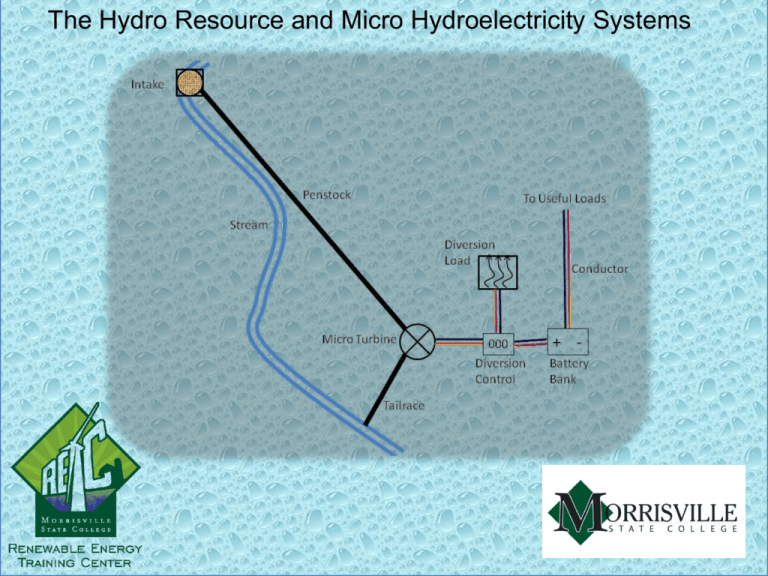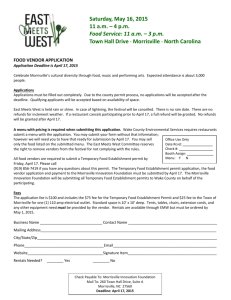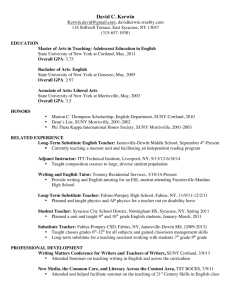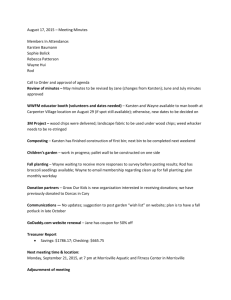Overview
advertisement

The Hydro Resource and Micro Hydroelectricity Systems The Solar Resource Overview • • • • Review of the Hydrologic Cycle System components Measuring head and flow Generating power from water (examples) 6/22/2009 http://retc.morrisville.edu 2 Hydrologic Cycle • Key terminology » Insolation » Evaporation » Transpiration » Evapotranspiration » Sublimation » Condensation » Precipitation » Infiltration 6/22/2009 » Sub-surface flow » Ground water discharge » Overland (surficial) flow » Freshwater storage » Oceanic storage http://retc.morrisville.edu 3 Hydrologic Cycle Insolation condensation sublimation Precipitation Transpiration Surficial flow Freshwater storage Oceanic storage Infiltration Subsurface flow 6/22/2009 Evaporation http://retc.morrisville.edu Groundwater discharge 4 Hydro Power • For most hydro systems, we are interested in only certain processes in this cycle » Oceanic storage (wave, tidal, ocean current) » Freshwater storage (wave, pumped storage, dams) » Overland flow (streams and rivers) • Though our systems use these processes, we must keep in mind that it is a cycle » Water is replenished in our systems due to incoming solar energy 6/22/2009 http://retc.morrisville.edu 5 Measuring the hydro resource In central New York, when do we get most of our precipitation? MSC mean rainfall (2003-2008) Inches of Rainfall 5 28 inches per year 4 3 2 1 0 6/22/2009 Jan Feb Mar Apr May Jun Jul Aug Sep Oct Nov Dec http://retc.morrisville.edu 6 Measuring the hydro resource 1500 Mean 2006 1000 500 Au gu Se st pt em be r O ct ob er No ve m De be r ce m be r Ju ly Ju ne ay M Ap ril 0 Ja nu ar y Fa br ua ry M ar ch Cubic Feet per Second Chenango River Discharge http://waterdata.usgs.gov/nwis/ 6/22/2009 http://retc.morrisville.edu 7 6/22/2009 http://retc.morrisville.edu 8 System components: Intake • Water enters penstock through the intake • Remove debris • High maintenance • Accessible 6/22/2009 http://retc.morrisville.edu 9 System components: Penstock • PVC » Cheap, light, and rigid » Low pressure systems » Easily available at hardware stores » Low losses (in straight sections) » Freezing issues 6/22/2009 http://retc.morrisville.edu 10 System components: Penstock • Polyethylene tube » Flexible » Longer lengths » Lower losses in sweeping bends » Freeze resistant » Expensive components » Difficult to purchase 6/22/2009 http://retc.morrisville.edu 11 System components: Turbine • High head, low flow • • • • 6/22/2009 1, 2, and 4 nozzle designs 12, 24, 48, VDC options 120 VAC options Pelton wheel with bronze runner http://retc.morrisville.edu 12 System components: Batteries • • • • Lead-acid Deep cycle Generally 2 to 6V Wet cell or sealed (gel) 6/22/2009 http://retc.morrisville.edu 13 System components: Charge controller • Monitors battery bank voltage • When the battery bank is “full”, electrons are diverted to a diversion load (a.k.a. dump load) • Can be jumped from 12,24, and 48 VDC depending upon input and battery bank (they must match!) 6/22/2009 http://retc.morrisville.edu 14 System components: Diversion Load • Waste electrons as quickly as possible • Resistance heating elements • Protect the battery bank 6/22/2009 http://retc.morrisville.edu 15 System components: Inverter • Converts direct current (DC) to alternating current (AC) • Can match the utility signal (voltage, shape and frequency) 6/22/2009 http://retc.morrisville.edu 16 Generating power Now that you understand the system components, how does one actually generate power with a micro hydro system? 6/22/2009 http://retc.morrisville.edu 17 Measuring the hydroelectric resource • Power generation from water is dependent on five variables: » P=ηρgQH » Power in watts (P) » Turbine efficiency (eta, η) » Water density (rho, ρ; usually 1000 kg/m3) » Acceleration of gravity (g, 9.81 m/s2) » Quantity of water flow (Q, in m3/s) » Vertical distance (head, H, in meters) 6/22/2009 http://retc.morrisville.edu 18 Measuring a stream – flow Flow rate (Q) • Quantity of water passing a given point over a given amount of time » Cubic meters per second » Gallons per minute » 1 GPM = 0.000063 m3/s 6/22/2009 http://retc.morrisville.edu 19 Measuring flow 6/22/2009 http://retc.morrisville.edu 20 Measuring the hydro resource - head Head (H) • Head is the vertical distance of the hydro system (from intake to turbine) • Relationship of head and pressure 2.31 feet 1 psi 6/22/2009 http://retc.morrisville.edu 21 Measuring head 6/22/2009 http://retc.morrisville.edu 22 Stream profile diagram 1,110 feet of penstock 6/22/2009 http://retc.morrisville.edu 23 Hydro power - example • Small stream: » 20 GPM flow, 140 feet of head, 85% turbine efficiency • • • 6/22/2009 Pressure: 1 psi 140 ft 60.6 psi 2.31 ft Flow: 0.000063 m 3 /s 0.00126 m 3 /s 20 GPM 1 GPM Head: 0.305 m 140 ft 42.7 m 1 ft http://retc.morrisville.edu 24 Hydro power: example • P= η ρ g Q H » Power = 0.85*1000 kg/m3*9.81 m/s2*0.00126 m3/s * 42.7 m » Power = 448.6 watts • Yearly energy in kWh? » 448.6 W *24 hrs/day * 365.25 days/yr = 3,932 kWh/yr • My house uses about 4,000 kWh/yr 6/22/2009 http://retc.morrisville.edu 25 Hydro power: what if? • If we go from 20 GPM flow and 140 ft of head to 140 GPM and 20 ft of head? • What power (watts) should I expect? • P= η ρ g Q H » Power = 0.85*1000 kg/m3*9.81 m/s2*0.00882 m3/s * 6.1 m » Power = 448.6 watts 6/22/2009 http://retc.morrisville.edu 26 Hydro power • Head and flow have equal importance in determining power (and energy) in a hydro system » What we have just calculated does not take penstock losses into account » This will reduce power output 6/22/2009 http://retc.morrisville.edu 27 Hydro power: a comparison • 20 GPM and 140 ft of Head • Yearly energy in kWh? » 448.6 W *24 hrs/day * 365.25 days/yr = 3,932 kWh/yr • My house uses about 4,000 kWh/yr 6/22/2009 http://retc.morrisville.edu 28 6/22/2009 http://retc.morrisville.edu 29 …to wind! • • • • • Class 3 site (7 m/s average; 15 mph) Turbine at 30% efficiency P=0.5* η ρ A V3 450 W = 0.5*0.3*1.2 kg/m3*(3.14*r2)*(7 m/s)3 r = 1.5 meters, diameter = 3 meters This means to get an equivalent amount of energy, I need a 10’ wind turbine rotor! 6/22/2009 http://retc.morrisville.edu 30 So, what bother with micro hydro? • • • • (Relatively) inexpensive Constant power production (not intermittent) Minimal impacts Turbines have high efficiency (80% to 90+%) Challenges • Not considered “renewable and sustainable” • Permitting process may be required • Highly selective sites • Currently cannot be net metered • Little knowledge of our resource 6/22/2009 http://retc.morrisville.edu 31 Contact Information Phil Hofmeyer, Ph.D. Assistant Professor Ph: 315-684-6515 Email: hofmeypv@morrisville.edu Web: http://people.morrisville.edu/~hofmeypv/ Ben Ballard, Ph.D. Director, RETC Assistant Professor Ph: 315-684-6780 Email: ballarbd@morrisville.edu Web: http://people.morrisville.edu/~ballarbd/ http://retc.morrisville.edu






